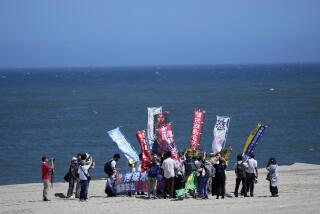2 Japanese nuclear workers hospitalized for radiation exposure
- Share via
Reporting from Tokyo — As Japan marked two weeks since the giant earthquake and tsunami, the number of people dead or missing grew to more than 27,000, with at least 200,000 others in shelters and radioactivity from a stricken nuclear plant continuing to cast a pall over daily life.
Two workers at the hobbled Fukushima Daiichi nuclear facility were hospitalized for radiation exposure Thursday after stepping into contaminated water during repair operations at reactor No. 3, officials at the nation’s nuclear safety agency said. A third exposed worker did not require hospitalization.
The Nuclear and Industrial Safety Agency said water in the turbine room where the workers were exposed registered about 10,000 times the level of radiation found in coolant inside a reactor. That could indicate there was damage to the core and a leak through the containment vessel, the agency said.
The two hospitalized workers received a dose of 170 to 180 millisieverts of radiation while laying electrical cables in the basement of the building housing reactor No. 3, officials said. The average American, by comparison, is exposed to 6.2 millisieverts of radiation a year from natural sources, according to the U.S. Environmental Protection Agency.
Water used in the cooling process seeped into the workers’ boots and came into contact with their skin, authorities said. The third worker was protected by his clothing. All three were equipped with radiation-detection devices, which sounded an alarm, but they continued to work, officials with Tokyo Electric Power Co. said. That revelation prompted Japanese nuclear officials Friday to call for a review of safety procedures at the site.
Water-spraying operations at reactor No. 3, interrupted Thursday by an evacuation, were expected to resume Friday.
Tokyo Electric Power, which operates the facility about 150 miles north of Tokyo, said 17 workers had been exposed to more than 100 millisieverts of radiation since the March 11 earthquake and tsunami disabled the cooling systems at the nuclear complex.
Meanwhile, in Tokyo, consumers continued to clear store shelves of bottled water a day after the government warned that infants should not be allowed to consume tap water because elevated levels of radioactive iodine from Fukushima were detected at a municipal treatment plant.
The levels of radioactive iodine-131, which had been double the level considered safe for infants under 12 months, later dropped to safe levels, prompting a cancellation of the warning. But the government continued distributing bottled water to 80,000 households with infants less than a year old.
Kakuzo Shiokawa bought four small bottles of water Thursday at the Ecchu-ya convenience store in Tokyo’s Ginza district, saying she didn’t grab more so that “other customers could have some too.” She said her daughter-in-law was two months pregnant and was worried about consuming tap water.
“It’s quite a panic,” Shiokawa said.
The U.S. Embassy in Tokyo advised pregnant women, and children under 3, to avoid tap water. Elevated levels of radioactive iodine were reported Thursday in tap water in Chiba prefecture. The government has found elevated levels of radiation in vegetables from several prefectures near the nuclear plant and imposed a shipment ban. On Friday, officials said they had detected contamination on vegetables grown in a government research facility in Tokyo.
Data compiled by the Mainichi newspaper suggest the cumulative amount of radiation in the air of Fukushima city, 40 miles from the plant, for the week of March 14-21 would have exceeded the average yearly radiation exposure for Japanese citizens. Although the data assumed a person would remain outside that entire time, the calculations raised questions about the long-term effects on those living near the plant.
The quake-tsunami death toll climbed past 10,000, with 17,541 missing, the National Police Agency said Friday. About 220,000 people remain in emergency shelters.
More: Articles, videos and graphics on radiation exposure, nuclear crisis
Times staff writer Thomas H. Maugh II in Los Angeles contributed to this report. Times wire services were also used.
More to Read
Sign up for Essential California
The most important California stories and recommendations in your inbox every morning.
You may occasionally receive promotional content from the Los Angeles Times.














